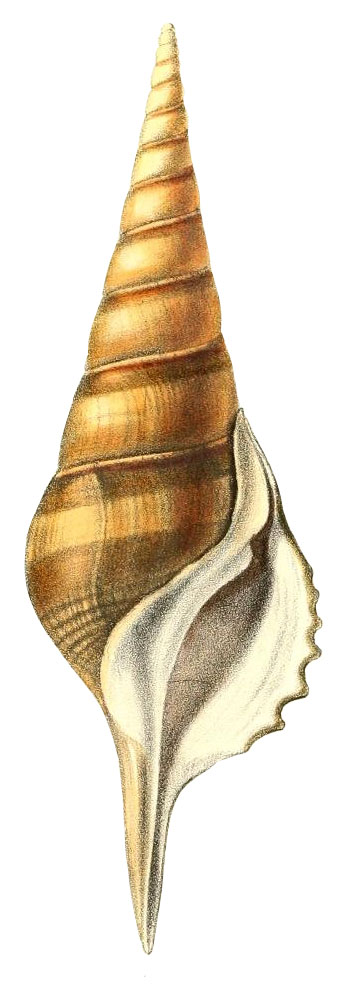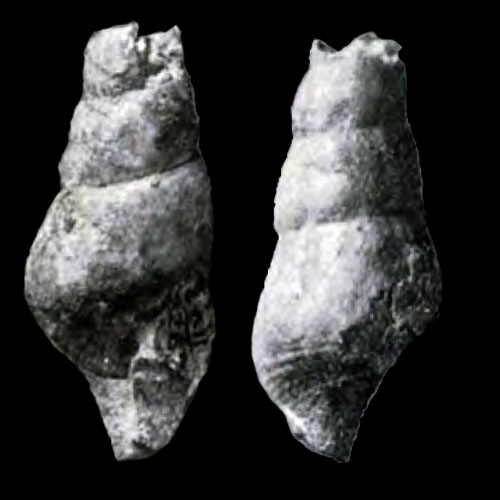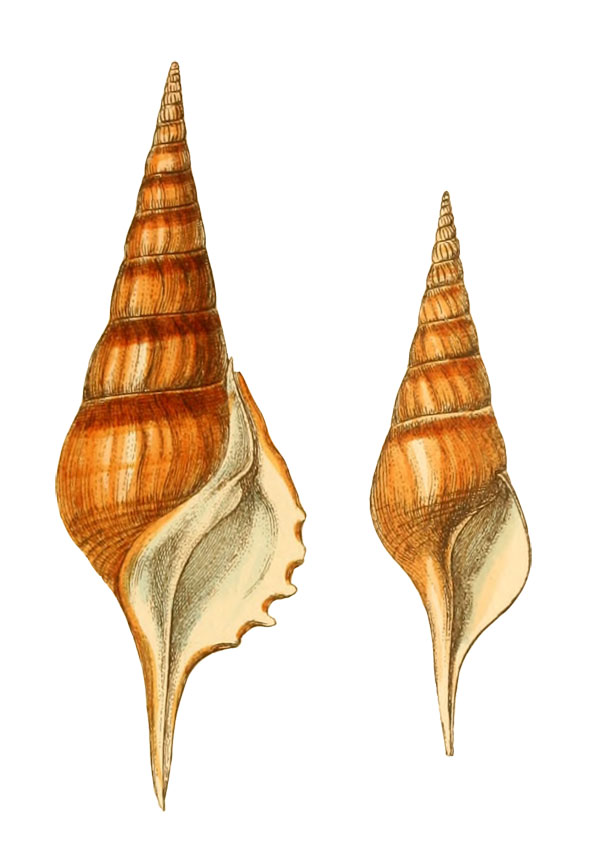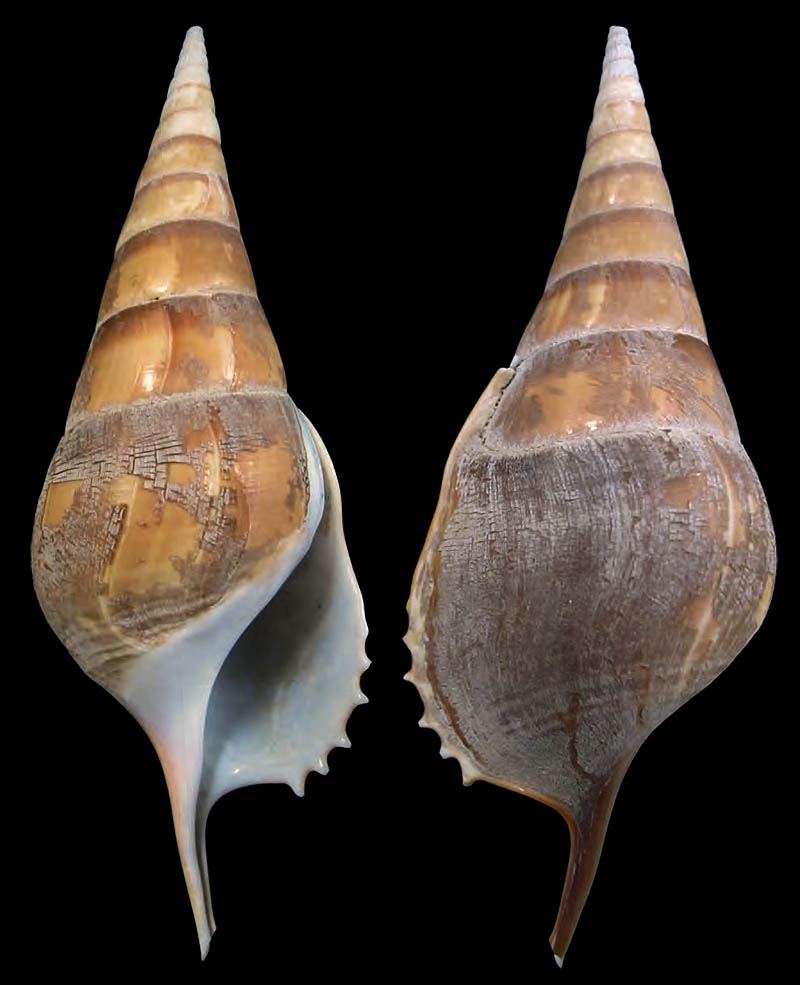|
edit SideBar
|
Stromboidea
Original description of Rostellaria curta by Sowerby II, 1842:
- "T. R. Curvirostro simillimā, sed anfractu ultimo breviori; canali recto."
- "The last whorl of this species is shorter than of R. Curvirostrum, and the canal is straight. There is a broad band of brown colour close to the suture of the whorls."
Sowerby gave no locus typicus.
Rostellaria curta in Sowerby, 1842, pl. V, fig. 7, 11
History and Synonymy
Tibia curta (Sowerby 2nd, 1842: 22, pl. 5 figs 7, 11) (Rostellaria)
- non Rostellaria curta Whitfield, 1892:109, pl. 13, figs. 9-13
1843
Description of Rostellaria curta by Sowerby II, 1843:
- "Rost. testā crassā, Iaevi, fusiformi; apice leviter plicatā; anfractibus numerosis planis; canali postico super anfractus penultimae partem decumbenti; canali antico brevi, recto; labio interno crasso; labio externo subexpanso, dentibus sex irregularibus; colore fulvo, fasciā latd castaneā partem posticam anfractuum decurrente."
- "The whorls of this species are flatter than in Rostellaria curvirostrum;.the last whorl is much shorter and the anterior canal is straight. The outer lip being irregular, led me at first to suppose that the specimen from which the description is taken might be one of the common species in which the completed aperture had been prematurely formed, it being well known that R. curvirostrum, in a young state, has the beak straight. But a slight difference in the shape of the whorls, the broad chestnut bands on the upper part of them, and the fact of several other specimens precisely similar having been seen by Mr. Cuming at Berlin, have determined me to describe this as a new species, which I now do with little hesitation."
1851
Description of Rostellaria curta in Reeve, 1851, p. 195:
- "Rostellaria curta. Rost. testa fusiformi-turrita, spira valde acuminata, canali recto, anfractibus subplanatis, paucis primis longitudinaliter costatis, caeteris laevibus, columella callosa, labro quadri- vel quinque-dentato, superne canaliculato-prodicto, canali breviusulo, subrecurvo; fulco-fuscerente, fascia latiuscula pallide castanea infra suturas, columella et aperturae fauce albis."
- "The short Rostellaria. Shell fusiformly turreted, spire very much acuminated, canal straight, whorls rather flattened, the first few whorls longitudinally ribbed, the rest smooth, columella callous, lip four- to five-dentate, canaliculately produced at the upper part, the canal being rather short and curved backwards; light fulvous-brown, with a rather broad pale chestnut band beneath the sutures, columella and interior of aperture white."
- "Sowerby, Pro. Zool. Soc. 1842."
- "Hab. -?"
- "The form of this shell is certainly distinct from any variety that I remember to have seen of R. curvirostris, from which it differs principally in the canal being straight. It is impossible to characterize the length of the canal, as it appears to have been filed at the extremity. The species has not been confirmed by the discovery of a second specimen."
 Rostellaria curta in Reeve, 1851, Rostellaria, pl. 3, fig. 9
1896
E.A. Smith, 1896, p. 370:
- "Rostellaria curta, Sowerby. Hab. Off the Sindh coast, in 20-30 fathoms."
- "I do not agree with Kiener and Tryon in considering this form a variety of the common R. curvirostris. The points of difference referred to by Sowerby and Reeve appear to be persistent; they consist of (1) the shorter body-whorl, (2) the longer and straighter canal, (3) the broad brown band beneath the suture. Judging from the description and figure, R. luteostoma of Angas, also considered by Tryon a variety of curvirostris appears sufficiently distinct."
1925
Rostellaria curta in Vredenburg, 1925, p. 320:
- "Large, extraconic. The earlier spire-whorls up to a diameter of about 6 millimetres are rather tall, their breadth only slightly exceeding their width, convex in outline with the maximum curvature close to the anterior suture. They are decorated with numerous delicate slightly curvilinear costae equal in width to the intervening spaces. Beyond this stage the other spire-whorls and the corresponding portion of the bodywhorl are broadly conical, short: either feebly convex, or with a perfectly flat outline devoid of any bulge or convexity. The sutures form linear grooves; near the aperture they show just the slightest tendency to a step-like disposition. These later spire-whorls are either perfectly smooth or else their only decoration consists of delicate, slightly curvilinear lines of growth. The base is decorated with rather fiat spiral threads of two sizes which alternate somewhat irregularly and are broader than the intervening spaces. The inner lip shows the characteristic tooth-like projection next to the posterior channel."
- "Occurrence.-This species occurs in the Mekran beds, both at the base of the Talar section, as well as from a higher horizon on the coast."
- "Comparisons.-This shell, especially the specimens from the higher horizon, agrees with the common living species of the neighbouring sea coasts so closely as to leave no doubt as to its identity."
 Rostellaria curta in Vredenburg, 1925, pl. IV, fig. 2a, b
Comment Wieneke: taxon inquierendum
2013
Liverani, 2013, p. 11:
- "Range: Persian Gulf and western Indian coast; out of the Persian Gulf along the coast of Oman to the Yemen Border. Does not reach the Red Sea."
Specimens from private collections:
Tibia curta (Sowerby, 1842); Gulf of Aden, Arabian Sea; Coll. Wolfgang Wranik
References:
- Reeve, L. (184378) [continued by G.B. Sowerby II] Conchologia Iconica; a complete repertory of species. London. 20 volumes. [Vols. 114 and parts of 15 and 16 are by Reeve; remainder by G.B. Sowerby II. Should be cited, by monograph, as a serial publication.], Fulltext
- E.A. Smith, 1896. Natural History Notes from H.M. Indian Marine Survey Steamer “Investigator“, Commander C.F. Oldham, R.N. - Series II., No. 22. Descriptions of new Deep-sea Mollusca; The Annals and Magazine of Natural History, vol. XVIII, 6th series, p. 367-374, Fulltext
- Sowerby, 1842. Proceedings of the Zoological Society of London, Part X, 1842, p. 165
- Sowerby, 1842
|




